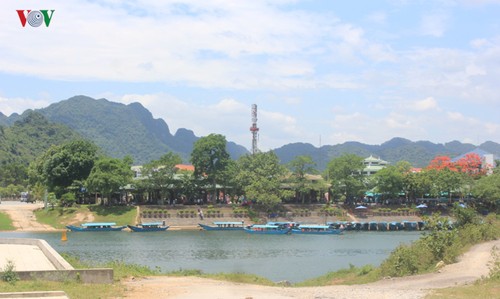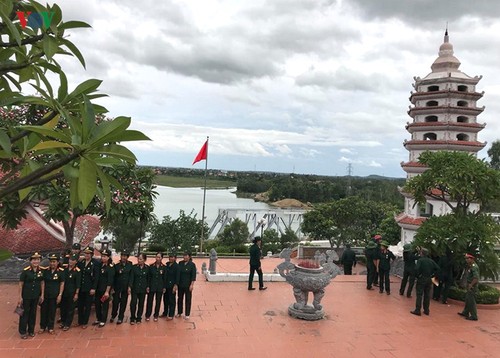 Xuan Son wharf along the Ho Chi Minh Trail Xuan Son wharf along the Ho Chi Minh Trail |
Khe Ho at the foot of Dong Noc mountain in Quang Tri province was a staging area for military supplies and soldiers of the 559 Battalion, a special force set up in 1959 to clear the route and transport troops, supplies, and information between the north and the south. In November, 2011, Khe Ho was recognized as a national relic by the Ministry of Culture, Sports, and Tourism. It is the beginning of a history tour along the Ho Chi Minh Trail, which takes visitors to the Ben Tat suspension bridge, the headquarters of the 559 Command, Ta Con airport, and the Eight Ladies Cave.
One of the major sites to teach young people about Vietnam’s revolutionary tradition is the Truong Son National Cemetery. Ho Thanh Phuc, a former Truong Son soldier, returned to the Ben Tat suspension bridge and the Truong Son National Cemetery to offer incense to his fallen comrades. Phuc said: “These places record Vietnam’s history for future generations. They are important historical relics and scenic spots.”
Quang Binh province, one of the first staging areas for military supplies heading for the southern combat zone, was devastated during the war. Quang Binh province has 121 historical relics, including 35 national relics and 18 special national relics, most of them located on the Ho Chi Minh Trail. Those sites and Phong Nha Ke Bang National Park, which was recognized by UNESCO as a World Natural Heritage Site, have drawn large numbers of Vietnamese and foreign visitors to Quang Binh province.
 Former soldiers visit Long Dai wharf and offer incense to their fallen comrades. Former soldiers visit Long Dai wharf and offer incense to their fallen comrades. |
According to Dang Dong Ha, Deputy Director of the provincial Department of Tourism, last year, 350,000 tourists visited Phong Nha cave, 50,000 visited Eight Ladies Cave, and 18,000 visited Long Dai wharf. Ha told VOV: “Tours to former battlefields and spiritual tours are new tourism products of Quang Binh. Local authorities have increased tourism promotion, worked on developing these historical sites to serve tourism, and invited travel agents to the relics to plan better tours.”
History tours remind visitors of the destruction of war while treating them to magnificent landscapes in central Vietnam along the way.